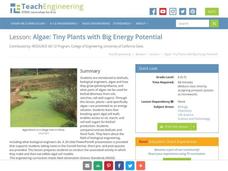Curated OER
Crazy Putty Ratio
Second graders use knowledge of measurements and ratios to mix various combinations of liquid starch and glue. They chart their ratios, make observations, and write a summary of the activity. They mix their own batch of Crazy Putty to...
Curated OER
PECKING OUT RATIOS
The student will practice writing ratios as fractions, using poultry-related illustrations as visual representations of the problems.1. Review the definition of a ratio and how to write ratios as fractions. If possible, use
groups of...
Teach Engineering
Algae: Tiny Plants with Big Energy Potential
My, what big energy potential you have! Scholars learn about the energy potential of using algae as a biofuel. A PowerPoint presentation first describes the structure of algae and then how researchers use algae as biofuel to produce energy.
Teach Engineering
Surface Tension Lab
What constitutes a good soap bubble? In the second installment of a nine-part series, scholars apply their understanding of surface tension to soap bubbles. They experiment to determine the best solutions to use for the...
Curated OER
Mitosis and Meiosis Exercise
In this cell division worksheet, students answer 15 multiple choice questions about both mitosis and meiosis. Topics include the outcomes of the processes, the phases of the processes and steps within each process.
Curated OER
Making Paper
Learners make paper from recycled paper. The student estimates, counts, and measures he amount of paper consumed in a classroom daily. They discover that if we use too much paper, it fills up landfills. Some activities they are doing...
Alabama Learning Exchange
Action at Plate Boundaries
Students diagram the spreading of the ocean floor. In this earth science lesson plan, students read an article on plate boundaries of the ocean. Students are expected to diagram the oceanic convergent boundary, and...
Khan Academy
Khan Academy: Break Apart 3 Digit Addition Problems
Practice breaking apart big addition problems using place value. For example, 234+567 is the same as 200+500+30+60+4+7. Students receive immediate feedback and have the opportunity to try questions repeatedly, watch a video or receive...
Khan Academy
Khan Academy: Breaking Apart Two Digit Addition Problems
In this exercise, students practice breaking apart two-digit addition problems. Students receive immediate feedback and have the opportunity to get hints and try questions repeatedly.
Khan Academy
Khan Academy: Break Apart 2 Digit Addition Problems
Practice breaking apart problems like 23+45 into problems like 20+40+3+5. Students receive immediate feedback and have the opportunity to try questions repeatedly, watch a video or receive hints.
Illustrative Mathematics
Illustrative Mathematics: 5.md: Breaking Apart Composite Solids
This exercise helps students understand how volume in figured, even when two or more parts of a prism are not overlapping. There is a teacher view, with a description of the activity and commentary, and a student view, with just the...
Other
Nearpod: Subtraction With Regrouping: Three Digit
In this lesson on subtraction, students will use the break apart strategy, draw a model, or the standard algorithm to subtract 3-digit numbers.
Other
Nearpod: Subtraction With Regrouping: Two Digit
In this lesson on subtraction, students will use the break apart strategy, draw a model, or the standard algorithm to subtract 2-digit numbers.
K-5 Math Teaching Resources
K 5 Math Teaching Resources: Division Strategy: Partition the Dividend [Pdf]
Break numbers apart as a strategy to divide.
Khan Academy
Khan Academy: Adding 53+17 by Making a Group of 10
Sal adds 53+17 by breaking apart the numbers and making a group of 10. [3:35]
Khan Academy
Khan Academy: Decompose Fractions With Denominators of 100
Practice breaking apart (decomposing) some number of hundredths into tenths and hundredths. Students receive immediate feedback and have the opportunity to try questions repeatedly, watch a video or receive hints.
Khan Academy
Khan Academy: 2 Digit Place Value Challenge
Practice breaking numbers apart into tens and ones. Students receive immediate feedback and have the opportunity to try questions repeatedly, watch a video or receive hints.














